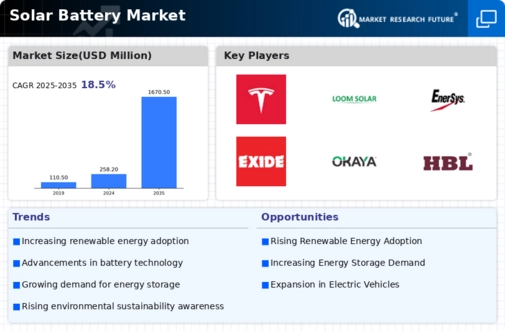Top Industry Leaders in the Solar Battery Market

*Disclaimer: List of key companies in no particular order
Latest Company Updates:
The solar battery market, fueled by the rising adoption of renewable energy, is experiencing a surge in growth and intense competition. Established players and new entrants are vying for market share, employing various strategies to cater to the diverse needs of customers across different segments. This dynamic landscape demands a closer look at the key players, their strategies, and the emerging trends shaping the competitive scenario.
Key Players and Strategies:
Traditional Battery Giants: Companies like LG Chem, Samsung SDI, and BYD leverage their established battery manufacturing expertise and extensive distribution networks to capture significant market share. They focus on continuous product innovation, particularly in lithium-ion battery technology, to offer high-performance and cost-effective solutions.
Emerging Players: Startups like Tesla and Sonnen are disrupting the market with innovative home energy storage solutions, offering seamless integration with solar panels and smart grid technologies. They prioritize customer-centric approaches, building brand loyalty through comprehensive energy management systems and user-friendly interfaces.
Regional Players: Companies like CATL and SVOLT in China are making significant strides, leveraging government support and economies of scale to offer competitive pricing and cater to the growing domestic demand for solar batteries. They are actively collaborating with local solar panel manufacturers to develop bundled solutions for residential and commercial customers.
Factors for Market Share Analysis:
Product Portfolio: The breadth and depth of battery offerings cater to diverse applications, from residential off-grid systems to large-scale grid storage projects. Players with a wider range of capacities, chemistries, and functionalities hold an advantage.
Technological Advancements: Continuous innovation in battery technology, including increased energy density, faster charging times, and improved safety features, is crucial for market leadership. Players actively investing in R&D and securing intellectual property rights gain a competitive edge.
Cost Competitiveness: Balancing performance with affordability is key. Players with efficient manufacturing processes, optimized supply chains, and economies of scale can offer competitive pricing and attract cost-conscious customers.
Regional Presence and Partnerships: Strong distribution networks, partnerships with local installers and solar panel manufacturers, and understanding of regional regulatory requirements are essential for capturing market share in specific geographic segments.
Emerging Trends and Competitive Dynamics:
Rise of Flow Batteries: Redox flow batteries are gaining traction for grid-scale storage due to their long lifespan, scalability, and safety advantages. Companies like ESS Inc. and Sumitomo Electric are actively developing and deploying these technologies.
Second-Life Batteries: Repurposing retired electric vehicle batteries for stationary storage applications offers a sustainable and cost-effective solution. Companies like Tesla and Nissan are leading this trend, providing a valuable second life to used batteries and reducing waste.
Virtual Power Plants: Aggregating distributed solar and battery resources into virtual power plants is transforming the energy landscape. Players like sonnenConnect and GridBeyond are enabling this transition, creating new market opportunities and disrupting traditional grid operators.
Overall Competitive Scenario:
The solar battery market is characterized by fierce competition, with players constantly innovating and adapting to meet evolving customer needs and market dynamics. Traditional giants are facing pressure from agile startups and regional players, while technological advancements and emerging trends are reshaping the competitive landscape. Success in this dynamic market will depend on a combination of factors, including technological leadership, cost competitiveness, regional focus, and strategic partnerships. As the market matures and demand surges, the players who can adapt and evolve the fastest will ultimately claim the lion's share of this lucrative and rapidly growing arena.
Axitec:
• In October 2023, Axitec announced the completion of a 100 MW/150 MWh solar farm with energy storage in Australia. This is one of the largest solar-plus-storage projects in the country. (Source: Axitec website)
Tesla:
• Tesla remains a leader in the residential solar battery market with its Powerwall product.
• In September 2023, the company announced a new version of the Powerwall with increased capacity and improved efficiency.
Energy Toolbase:
• Energy Toolbase provides a software platform for designing, managing, and optimizing solar and storage systems.
Kokam Company:
• Kokam specializes in lithium-ion batteries for various applications, including energy storage.
• In December 2021, the company merged with Shift Clean Energy to focus on marine and industrial energy storage solutions.
Alpha Technologies Inc.:
• Alpha Technologies is a smaller player in the solar battery market, but it is known for its innovative battery designs.
Top listed global companies in the industry are:
Axitec
Tesla
Energy Toolbase
Kokam Company
Alpha Technologies Inc.
Battery Energy Power Solutions Pty
HBL Power Systems Ltd
East Penn Manufactuting Co Inc.
System Sunlight SA
Panasonic

